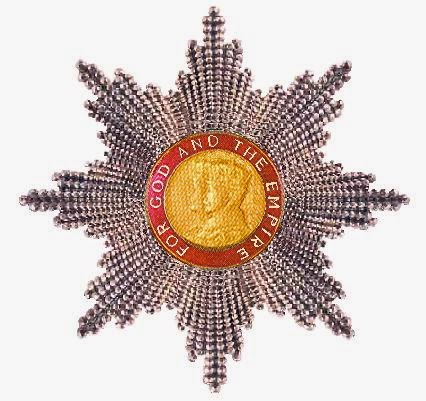 |
| Star of the Order of the British Empire [1] |
Today, there are separate civil and military divisions of the order, but the qualifications for belonging to either remain the same: members of the order must have made a significant contribution to the nation at the local, regional, or national level. The five ranks of the order — Knight/Dame Grand Cross (GBE), Knight/Dame Commander (KBE/DBE), Commander (CBE), Officer (OBE), and Member (MBE) — are generally awarded based on the scope of the member’s contribution. For example, local achievements are often honored with MBEs, while a national contribution will be honored with a CBE or even a knighthood [3].
The Order of the British Empire is the most junior of the orders of British chivalry, following just after the Royal Victorian Order in precedence. Any Briton, man or woman, who has made significant contributions to the nation can be nominated to receive it. (Some citizens of Commonwealth realms are also entitled to become members of the order.) Occasionally, it’s also awarded to foreign nationals to honor their contributions to Britain; this is usually done on an honorary basis, as members of the order are required to swear allegiance to the Queen. For example, Bill Gates is an honorary knight commander of the order, but because he’s American, he’s not called “Sir Bill” — though he can use the initials KBE after his name if he wants.
Knights and Dames Grand Cross of the order are entitled to wear the order’s mantle, collar, and star. (The star can also be worn by Knights and Dames Commander; you can see Dame Angela’s star behind her badge above.) The mantle, pictured above on Queen Elizabeth II (the sovereign of the order), is made of red silk (Debrett’s calls the specific color “rose pink” [4]) with a gray lining. It features an embroidered version of the order’s eight-pointed star, which features portraits of King George V and Queen Mary [5] encircled by the order’s motto. (Interestingly, this is one of the orders of chivalry that does not include sashes as a part of the insignia.)
The collar is made of gold and features the royal arms interspersed with the cypher of George V. On the order’s “collar days,” the badge is worn suspended from the collar by Knights and Dames Grand Cross. Most of the collar days are religious festivals, but collars are also worn on the Queen’s accession day (February 6), Prince Philip’s birthday (June 10), Restoration Day (May 29), and Coronation Day (June 2). The best chance to see Knights and Dames Grand Cross in all their finery (like the Queen, pictured above in 2012) is at the prayer service for the order, held every four years at St. Paul’s Cathedral in London, where there is a chapel for the order in the cathedral crypt [6]. The next service will be held in 2016.
On regular days, the badge of the order is worn suspended from a rose-pink ribbon. You can tell a civil member of the order from a military member by looking at the ribbon: military members have a gray stripe running down the center of the ribbon. The badge is a cross patonce that features the images of George and Mary in the center on one side, with George V’s cypher on the other. The higher your rank, the bigger your badge; the colors also differ according to rank, with MBEs having silver crosses, OBEs gold crosses (seen above on David Beckham at the royal wedding in April 2011), and CBEs/KBEs/DBEs/GBEs blue and crimson enameled crosses. As of December 2006, all members of the order are also eligible to wear a lapel pin that features an image of the order’s badge.
As so many are eligible to become members of the order — if you fit the main national criteria, you can be nominated, and various government officials do the appointing rather than the Queen — there are tens of thousands of living people who belong to its various ranks. Intriguingly, two of the members of the lowest rank are also members of the royal family: Mike Tindall and Zara Phillips (granddaughter of the Queen, pictured above after receiving her MBE in 2007), who were both recognized for their sporting contributions. And there have been lots of others who were offered membership at different levels but turned it down or renounced it later for various reasons, including C.S. Lewis, T.E. Lawrence, Doris Lessing, John Lennon, and Roald Dahl.
(And, if you take nothing else away from this post, you now know the answer to the question “what do Angela Lansbury, David Beckham, and Zara Phillips have in common?”)
NOTES, PHOTO CREDITS, AND LINKS
1. Image available via Wikimedia Commons; source here.
2. The name of the order has remained the same even after the British empire transitioned into the Commonwealth of Nations. Some have boycotted the order because they feel the name is too linked to an imperial past.
3. See the official government page on the various levels of membership here.
4. More on the order at the Debrett’s website here.
5. Insignia made before 1937 feature an image of Britannia rather than of the king and queen.
6. More from the official website of the British monarchy here.
Leave a Reply